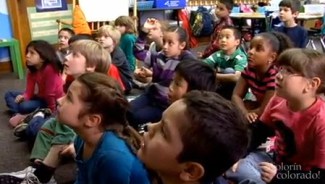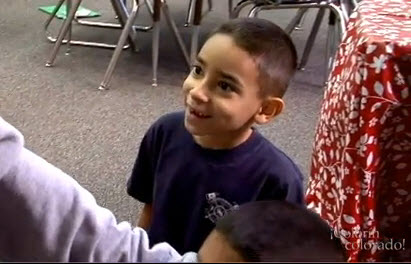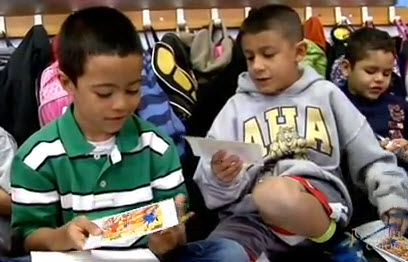Read Alouds Benefit English Language Learners by

In this blog post written for Colorín Colorado, Rhode Isle administrator and WIDA trainer Julie Motta walks through a read-aloud activity for first grade and highlights how she engaged the students with the story, brought in content-expanse connections, and included informal assessment to cheque comprehension. She also outlines the standards related to the activity. To see more from Julie, take a look at her previous blog postal service focused on making curriculum units aligned to the Common Core accessible for ELLs!
Getting Back to the Classroom
Although I have been out of the classroom for a while as I have taken on more responsibilities equally a central office administrator in Rhode Island, the best parts of my task remain spending time with students inside their busy classrooms and working with their teachers to continually advance their craft, especially in the multifaceted chore of implementing the Common Core Land Standards (CCSS) with ELLs.
 This past bound, I was in a classroom reading to eager first graders sitting attentively on their alphabet rug during Reading Week. The theme of the week was "Read around the World." The class had been hearing stories based on different cultures, so to continue with the theme, I chose a multicultural story entitled Let's Consume by Ana Zamarano. With merely this unproblematic read aloud, I was able to piece of work on the WIDA English Language Evolution ELA, Math, and Science Standards while I addressed the CCSS in Reading, Speaking & Listening, and Math. The action reminded me that many of the things that I do naturally as an ESL teacher are effective for all students, and that they also are great strategies to use in implementation of the Common Cadre. A table of the standards I worked with is listed below.
This past bound, I was in a classroom reading to eager first graders sitting attentively on their alphabet rug during Reading Week. The theme of the week was "Read around the World." The class had been hearing stories based on different cultures, so to continue with the theme, I chose a multicultural story entitled Let's Consume by Ana Zamarano. With merely this unproblematic read aloud, I was able to piece of work on the WIDA English Language Evolution ELA, Math, and Science Standards while I addressed the CCSS in Reading, Speaking & Listening, and Math. The action reminded me that many of the things that I do naturally as an ESL teacher are effective for all students, and that they also are great strategies to use in implementation of the Common Cadre. A table of the standards I worked with is listed below.
Reading the Story Together
Before Reading
 Before I read the story, I congenital groundwork with students by request them about the brand-upwards of their families and the ways they gathered for meals. This got them interested in the family whom we would read about. I charged them with making comparisons and contradictions to their ain family practices as their purpose of listening intently.
Before I read the story, I congenital groundwork with students by request them about the brand-upwards of their families and the ways they gathered for meals. This got them interested in the family whom we would read about. I charged them with making comparisons and contradictions to their ain family practices as their purpose of listening intently.
During Reading
As I read the story, the children listened carefully. They made predictions and answered my questions. Some questions that I asked were:
- Can you tell me why y'all think the mom was happy when everyone was at the dinner table?
- What information from the story makes you say that?
- Who might exist missing from the dinner table on Tuesday?
- Why do you lot think it will be that family member?
- Was in that location a clue in the story that helped yous to make that prediction?
After Reading
Once we finished the story, I used prompts for pupil give-and-take, such every bit:
Plow and talk to you elbow partner nigh why you call up having dinner together is so important in this family. Be sure to use some words from the story to testify your idea is a good one.
I probed them using phrases similar:
- Tell me more most that.
- What makes you lot say that?
- Is there a picture in the story that is making you lot think that fashion?
I required them to provide me with evidence from the story to support their thinking. I insisted that they give responses in complete sentences, using sentence frames with those who needed a bit of scaffolding.
Content Connections
Math
In addition to our discussion of the text, the children studied the watercolor illustrations, and we used these illustrations to do some grade level math, adding and subtracting members of the family unit who disappeared and and so reappeared on each page of the story. Later they would write number stories using the characters names during their math instructional block.
Art
One pupil too explained how the form had been given a gamble to use watercolor paints in art course. If I had been in the school for a longer menstruation of time, I would take followed up with the art teacher to ask her to use the book to talk over the illustrator's purpose for using watercolors so that the children could do some deeper assay, thus promoting shared responsibility for assisting students with coming together rigorous content standards. Additionally, if I'd had the chance, I also would have picked some additional books virtually families and had the children report the illustrations to compare their artistic components in exhibiting families.
Health
Every bit each nutrient that was mentioned in the story was described, I used Google images of the actual foods to match the descriptions. This led u.s. to an in-depth discussion of salubrious foods, and the students were able to make connections to what they had been learning about in health class where they had been listening to advisory texts around healthy foods, some other take a chance to promote the shared responsibility mentioned higher up. This was another opportunity for comparison the foods in the story to those that the children ate with their families on a regular basis and to analyze how salubrious they were in comparison to the foods in the story.
The children actively participated as the story continued, repeating a phrase from the book that was stated in both English (What a compassion!) and Castilian (¡Ay qué pena!), expressions that Mamá used when a family unit member was non at the dinner tabular array. We talked about why the author would have chosen to use these phrases repeatedly throughout the text.
Informal Assessment
I had students cocky-assess using a listening and speaking rubric based on the WIDA performance definitions. They rated themselves on a scale of one-5 using the sentences here to assess their own listening:
- I can understand the words in the story.
- I can empathise the brusk sentences in the story.
- I can understand the long sentences in the story.
- I tin can understand people'southward ideas in the story.
- I tin understand the whole story that I listened to.
For speaking, they used these sentences:
- I tin can talk using a few words virtually the story.
- I can utilize brusk sentences to talk about the story.
- I can use long sentences to talk about the story.
- I can put my ideas together when I talk well-nigh the story.
- I can retell the story to a friend in my own words.
I suggested post-obit up with a writing prompt that the students could observe success with. An instance I gave as a proposition was: Write (a specific number of words, phrases or sentences – based on varying proficiency levels of individual students) that explains why dinner time was so important to the mom in this story. Be sure to detect (insert a number) reasons in the story that show that your idea is correct. A word depository financial institution would exist provided with the prompt as well as incomplete sentences with some words missing that students with the least proficiency could fill in.
Collaboration
Finally, I was able to use this opportunity for the benefit of the teacher who had invited me as a invitee to her classroom. I worked hard to model by:
- asking rigorous, probing questions that required evidence to back up answers
- allowing for wait fourth dimension
- using rich, bookish vocabulary including cognates
- encouraging peer discussions with turn and talk
- making links to advisory texts that would lend themselves to extend the lesson.
The Luckiest Teacher in the World
During this lesson, I realized that implementing the Common Core with ELLs does not have to be as hard as I had originally thought – and that a lot of what I learned how to do as an ESL teacher supports the Mutual Core beautifully. At the conclusion of the story, I explained to the students in this classroom that I had taught children who had just moved to the US from all over the earth. I told them that I taught those children to speak English, and I named the many countries they had come up from. 1 darling little boy squealed, "Mrs. Motta, you lot were the luckiest instructor in the globe!" And indeed, he was admittedly correct – I was! And whether in my classroom with my ELLs or sitting on this rug in a mainstream grade-one classroom, I was providing my students with rigorous content knowledge as they acquired rich academic vocabulary in the English language. The students may accept had differing needs, but the high-quality pedagogy was the same in both instances.
Standards Used for Read-Aloud
| Common Core Land Standard | WIDA Standards | |
| Math one.0A Operations & Algebraic Thinking- Represent and solve issues involving addition and subtraction |
|
|
| RL i-iii Key Ideas and Details |
|
|
| RL 4 Arts and crafts and Structure |
|
|
| RL 7 & 9 Integration of Knowledge and Ideas |
|
|
| SL 1-2 Comprehension and Collaboration |
|
|
| SL 4 & 6 Presentation of Knowledge and Ideas |
|
|
| L1 Conventions of Standard English language |
|
|
| L 5& 6 Vocabulary Conquering and Utilise |
|
|
Related Resources
 To see more great strategies in action, take a look at Colorín Colorado's Common Core classroom videos and lesson plans for beginning grade featuring instructor Ali Nava in Albuquerque, NM presenting lessons based on the children's book Burro'southward Tortillas, a southwestern adaptation of "The Little Red Hen." Strategies and activities include:
To see more great strategies in action, take a look at Colorín Colorado's Common Core classroom videos and lesson plans for beginning grade featuring instructor Ali Nava in Albuquerque, NM presenting lessons based on the children's book Burro'southward Tortillas, a southwestern adaptation of "The Little Red Hen." Strategies and activities include:
- Introducing Burro's Tortillas
- Interactive reading of a story
- Making text-to-text connections
- Writing a cooperative paragraph
- Using "realia" to build background
Virtually the Author
 Julie Motta is the Assistant Superintendent of the Eastward Providence Schoolhouse District in Rhode Isle. Formerly the ESL Director of Pawtucket Schools, she is also a WIDA trainer and an adjunct higher professor at Rhode Island Higher and Providence College, where she has taught courses in Second Language Acquisition, Curriculum and Methods, Social Issues, and Culturally Responsive Pedagogy.
Julie Motta is the Assistant Superintendent of the Eastward Providence Schoolhouse District in Rhode Isle. Formerly the ESL Director of Pawtucket Schools, she is also a WIDA trainer and an adjunct higher professor at Rhode Island Higher and Providence College, where she has taught courses in Second Language Acquisition, Curriculum and Methods, Social Issues, and Culturally Responsive Pedagogy.
Source: https://www.colorincolorado.org/blog/common-core-ideas-using-read-alouds-english-language-learners
0 Response to "Read Alouds Benefit English Language Learners by"
Post a Comment